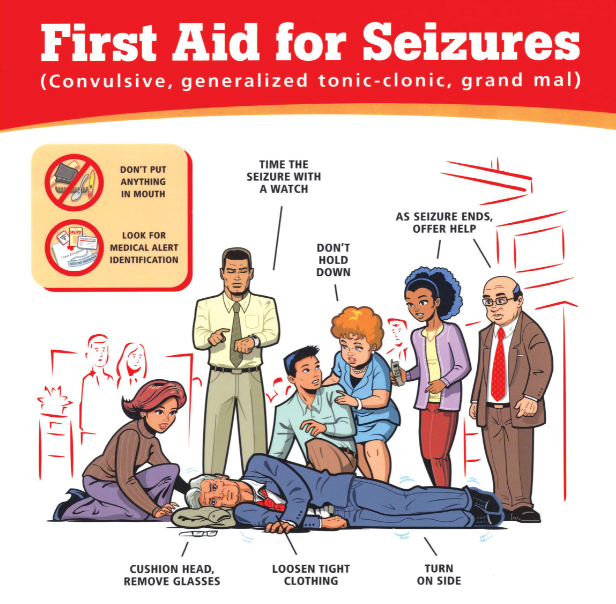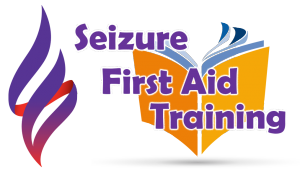
BASIC SEIZURE FIRST AID
- Stay calm and reassure others nearby.
- Time the seizure with your watch.
- Clear the surrounding area (remove hard or sharp objects).
- Don’t hold the person or try to stop his/her movement
- If consciousness is lost, put something flat and soft, like a folded jacket, under the head.
- Turn him/her gently onto one side as this will help keep the airway clear.
- Loosen ties or anything around the neck that may make breathing difficult.
- Do not force the mouth open.
- Don’t attempt artificial respiration except in the unlikely event that the person does not start breathing again after the seizure has stopped.
- Stay until the seizure ends naturally.
- Be friendly and reassuring as consciousness returns. Offer to call a taxi, friend, or relative to help the person get home if he/she seems confused or unable to do this alone.

Take A.C.T.I.O.N. – Quick Steps
A – Assess the Situation: Is the person in danger? Remove nearby objects.
C – Cushion the head for protection.
T – Time: Check the time. If the seizure lasts longer than five minutes, call an ambulance.
I – Identity: Look for a medical bracelet or ID card. It may give you information about the person’s seizures and particular things to do.
O – Over: Turn the person on his/her side when possible. Stay and provide reassurance.
N – Never restrain the person, put something in his/her mouth, or try to give food or drink.
When to Call an Ambulance
No Need To Call An Ambulance If:
- Seizure ends in under 5 minutes
- Consciousness returns without a further incident
- No signs of injury, physical distress, or pregnancy
An Ambulance Should Be Called If:
- No medical I.D. and no way of knowing whether the seizure is caused by epilepsy
- Person is pregnant, injured, or diabetic
- Seizure continues for more than 5 minutes
- Seizure has happened in water
- Second seizure starts shortly after the first has ended
- Consciousness does not return after the shaking has stopped
* If the ambulance arrives after consciousness has returned, the person should be asked whether the seizure was associated with epilepsy and whether emergency room care is wanted.
SEIZURE RESCUE MEDICATION
SB 161: Seizure Rescue Medication in Schools
On October 7, 2011, California Governor Jerry Brown signed California Senate Bill 161 into the law which authorizes school districts to provide school employees with medical training to administer emergency medical assistance to pupils with epilepsy suffering from prolonged seizures. The bill allows emergency intervention, such as the use of Diastat, for prolonged seizures to be accessible to volunteer, trained non-medical individuals in the absence of a licensed nurse onsite at the school. The bill also authorizes a school district to provide school employees with voluntary emergency medical training to provide medical assistant to individuals with epilepsy suffering from prolonged seizures.
According to neurologist Dr. Arthur Partikian, “A prolonged seizure that is not treated appropriately and in a rapid manner can result in a brain injury, and that is why this bill was so important for our children.” If not treated at the appropriate time, prolonged seizures have the potential to cause brain injury and even death, making immediate emergency medical assistance imperative.


SCHEDULE A LIVE VIRTUAL TRAINING
We offer free Seizure First Aid trainings for the community.
Our presentation topics include Epilepsy 101, identification of seizures types, and basic first aid tactics. Free trainings are provided at a need basis to our communities. Please reach out to schedule a date/time to get Seizure First
Aid trained. Following each training, the participants can set up an individual meeting if they would like to be a Seizure First Aid trainer and train others in the community.
